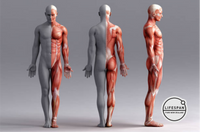
In search of relief for sore muscles and aching joints?
Our Joint and Muscle Cream is here to help! Enriched with natural ingredients, including Green Lipped Mussel oil and Arnica, it's the ideal solution for the active individual. Welcome soothing comfort and bid farewell to sore muscles and joints, while ensuring your skin remains vibrant and well-nourished.
Recent posts
-

-
 Soothing Sore Knees: The Power of Joint CreamsBy Ben Winters
Soothing Sore Knees: The Power of Joint CreamsBy Ben Winters -
 Joints and Muscle Creams for Athletes and Active PeopleBy Ben Winters
Joints and Muscle Creams for Athletes and Active PeopleBy Ben Winters

About the Author
Guiding Lifespan's to the best quality joint supplements, Ben Winters infuses his dedication to natural wellness into our Green Lipped Mussel Cream. With a keen eye on sustainable practices and innovative product formulation, Ben guarantees the highest quality of every batch. Tailored for those with an energetic lifestyle, this cream stands as a reflection of Ben's devotion to superior quality and efficiency, providing fast relief for joint and muscle discomfort. Immerse yourself in a blend of nature's finest and cutting-edge science with each application

Muscle Warm-Up and Cool-Down, Injury Prevention for Runners
By Ben Winters
Muscle care and injury prevention are something every runner cares about, regardless of whether they are a casual jogger or a dedicated marathon runner.
Running, by its very nature, places repetitive stress on the body, particularly on the muscles and joints. This consistent demand can lead to a range of issues, from minor aches and pains to more serious injuries like stress fractures or chronic tendonitis.
For casual joggers, the risk might seem minimal, but even short, regular runs can lead to injuries if proper muscle care is not taken. Warm-ups, cool-downs, and appropriate stretching are fundamental practices that help maintain muscle flexibility and reduce the risk of strains and sprains.
The importance of injury prevention escalates for those who engage in marathons and long-distance running.
The extended duration and increased intensity of these activities significantly amplify the strain on muscles and joints. Long-distance runners must not only adhere to basic muscle care practices but also incorporate advanced strategies like comprehensive strength training, specialised stretching routines, and meticulously planned nutrition and hydration strategies.
These practices help in building endurance and resilience, crucial for preventing overuse injuries. Understanding the nuances of muscle care and injury prevention across different levels of running ensures that runners can enjoy their sport safely and sustainably, minimising downtime due to injuries and maximising the health benefits and enjoyment that running brings.

To care for the muscles and help to prevent injury it is important to incorporate a proper warm-up and cool-down routine.
A good warm-up routine gradually activates the cardiovascular system, increases blood flow to the muscles, and raises body temperature, which is crucial in preventing injuries. This should begin with 5-10 minutes of light aerobic exercises like brisk walking or jogging. This can be followed by dynamic stretches such as leg swings, arm circles, and gentle lunges, preparing the muscles and joints for the activity ahead.
Equally important is the cool-down phase. After running, it's recommended to spend another 5-10 minutes doing a slow jog or walk to gradually bring the heart rate down. This practice aids in removing waste products from the muscles, reducing stiffness and soreness.
Flexibility is a key element in preventing injuries.
After the cool-down phase, static stretching should be performed, focusing on major muscle groups that are used in running, such as the calves, hamstrings, quadriceps, hip flexors, and glutes. Each stretch should be held for about 15-30 seconds, ensuring there is no pain. Stretching should feel relieving, not painful.
Regular stretching not only improves flexibility but also aids in muscular recovery and prevents tightness, which can lead to injuries.
Incorporating the use of topical creams into a warm-up and cool-down routine can offer additional benefits for runners.
These creams can provide a warming or cooling sensation that aids in muscle relaxation.
During warm-up, applying a heating cream can help increase blood flow to the muscles, making them more pliable and prepared for the physical exertion of running. This can be particularly beneficial in colder weather, where muscles are more prone to stiffness.
Conversely, in the cool-down phase, cooling creams can be effective in soothing tired and sore muscles. They provide a calming effect and can help muscle fatigue.
However, it's important for runners to be mindful of their skin's sensitivity to these products and to use them as directed. While these creams can be a useful adjunct to physical warm-up and cool-down exercises, they should not be relied upon as a sole method of injury prevention.
Integrating a comprehensive warm-up and cool-down routine is an essential part of muscle care and injury prevention for runners.
For both casual joggers or endurance marathon runners, the emphasis on preparing the muscles for the demands of running and aiding in their recovery post-run cannot be overstated.
The combination of light aerobic exercises, dynamic and static stretching, and the strategic application of warming or cooling creams works synergistically to enhance muscle flexibility, improve blood flow, and alleviate muscle fatigue.
This holistic approach is critical in minimising the risk of common running-related injuries. By adopting these practices, runners can not only prevent the short-term discomfort of muscle strains and sprains but also safeguard against more serious long-term injuries.
Furthermore, these routines aid in optimising running performance, ensuring that runners can continue to enjoy and excel in their sport while maintaining their physical well-being.
Ultimately, the key to a rewarding running experience lies in the careful attention to muscle care and injury prevention, ensuring longevity and joy in the sport.



